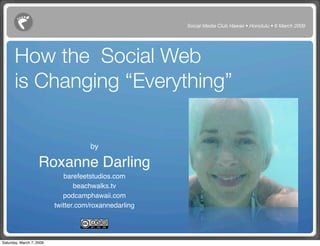The Social Web is Changing "Everything"
- 1. Social Media Club Hawaii ? Honolulu ??6 March 2009 How the Social Web is Changing Ī░EverythingĪ▒ by Roxanne Darling barefeetstudios.com beachwalks.tv podcamphawaii.com twitter.com/roxannedarling Saturday, March 7, 2009
- 2. Social Media Club Hawaii ? Honolulu ??6 March 2009 Customers hold the keys to your brand. Saturday, March 7, 2009
- 3. Social Media Club Hawaii ? Honolulu ??6 March 2009 While you are busy in your business... others are talking about you. Saturday, March 7, 2009
- 4. Social Media Club Hawaii ? Honolulu ??6 March 2009 Shouting is so last century. Saturday, March 7, 2009
- 5. Social Media Club Hawaii ? Honolulu ??6 March 2009 Listening is the secret sauce on the social web. Saturday, March 7, 2009
- 6. Social Media Club Hawaii ? Honolulu ??6 March 2009 Build your list. Saturday, March 7, 2009
- 7. Social Media Club Hawaii ? Honolulu ??6 March 2009 Get out and participate. Saturday, March 7, 2009
- 8. Social Media Club Hawaii ? Honolulu ??6 March 2009 WhatĪ»s New? Saturday, March 7, 2009
- 9. Social Media Club Hawaii ? Honolulu ??6 March 2009 Is your website too pretty? Saturday, March 7, 2009
- 10. Social Media Club Hawaii ? Honolulu ??6 March 2009 Search is the new Home Page. Saturday, March 7, 2009
- 11. 11 Social Media Club Hawaii ? Honolulu ??6 March 2009 Roxanne Darling ? Find Me Here: barefeetstudios.com beachwalks.tv twitter.com/roxannedarling roxanne@barefeetstudios.com Think Green: please avoid printing this ?le and enjoy it on your computer instead! Saturday, March 7, 2009
Editor's Notes
- #3: They are making their own media (“social media”) that incorporates the things they love and hate. Seth Godin’s Blog Direct From Consumer. They are telling their friends on “social networks.” The best way to control the brand is to be part of the conversation.
- #4: First: Find out what others are saying. Google yourself and your brand. Set up Google Alerts to stay informed. Use search.twitter.com. Create tags and track them across social sites. #pch08 twitter and flickr.
- #5: Second: Stop shouting. Interruption marketing and shouting, via banner ads, pre-roll video ads, popup ads, etc. create negative associations with you and your company.
- #6: Third: Listen How and where do you listen? Have a blog, allow comments, respond to them. Participate on Twitter, Facebook, LinkedIn, etc.
- #7: Your power comes from the community. Build a network like The Reef. Build your email list. Give people a way to interact with you.
- #8: Blog. Podcast. Use internet video (post messages and specials via viddler, etc.) Tag your stuff. Ask for feedback. Dell: IdeaStorm.com = build the site then let users post suggestions, discuss them, then vote up or down. Free marketing R&D.
- #9: How do users find your new web content? Can they see the forest for all the trees, or do you rarely plant new trees? Blogs automatically feature the newest content on the home page. And then categorize it for archiving and easy retrieval later.
- #10: 100% Flash sites are dead. Too hard to update. Not search-friendly. Goes stale very quickly. Does not encourage organic exploration of your content. Does not allow users to share your content with others. Messy & Lively are More Important than pretty. Function is much more important than form. People are in a hurry and want to be in control.
- #11: External search via Google for deep inbound links. Alltop: twitter 25% of organic Google; 10X more than Facebook. unique, shortened URLs Search engine built-in to your site for users. (Included with blog software.)
- #12: More details and specific examples in Part 2.











